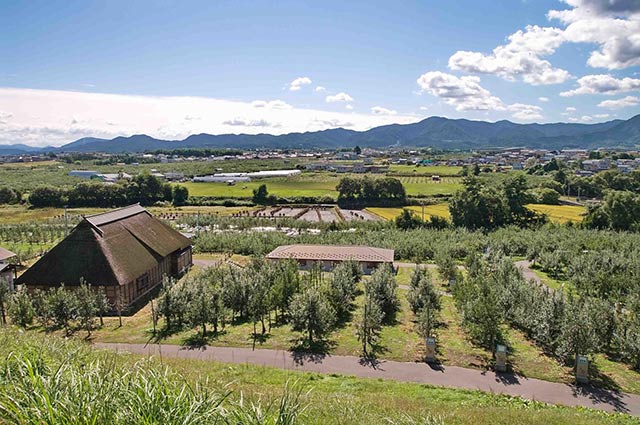
Japan is famous for really delicious fruit. Rather than eat the expensive stuff from speciality shops and supermarkets, why not pick your own fresh from the tree?
-
Seasonal foods are a big deal in Japanese culture. On top of that, Japanese fruit tends to be of really high quality. One interesting twist to put on your trip is to get out of the big city and pick fresh fruit. It’s a nice activity to add on to your onsen stay as well. You can pick all kinds of fruit all over the country, but we chose 5 autumn fruits and the 5 prefectures most famous for them.
Generally speaking, there are two basic systems for picking fruit so the two Japanese words you’ll need to know for this are 食べ放題 tabehodai (all you can eat) and ~狩り gari (picking). The former is usually unlimited, the latter tends to have a time limit. Alright then, let’s look at some farms!![Grapes]()
Grapes
-
02
Grapes in Yamanashi
Japanese name: ぶどう budo
Season: August to October
Katsunuma, Yamanashi is the grape capital of Japan. If you’re in Yamanashi to visit Mt. Fuji, why not enjoy some grapey goodness? Katsunuma Grapark (combining the words “grape” and “park”) grows over 16 varieties and offers 2 plans. One is a tabehodai (1000 yen for normal species, 2000 yen for high end ones) – all you can eat, no time limit, but you can’t take anything with you. The other is the budo-gari plan – 100 yen per 100 grams of normal grapes, 200 yen per 100 grams for the premium kind. While you’re in town, you also might want to pop into the ぶどうの国文化館 Budo no Kuni Culture Hall and learn about the history of Katsunuma, grape cultivation, and wine production.
Katsunuma Budokyo Station is 10 minutes from Yamanashi Station by train. Just take a bus or taxi another 15 minutes to Katsunuma Grapark.![Apples]()
Apples
-
03
Apples in Aomori
Japanese name: りんご ringo
Season: September to November
In Japan, Aomori is synonymous with apples. In fact, 70% of all apples in Japan are produced here. At Aomori Sightseeing Apple Garden they grow 26 varieties on roughly 250 trees. They have 2 plans. One, you can pick 3 apples for 300 yen. Two, if you’re feeling like a glutton, you can do a one hour tabehodai for 1000 yen. They also grow pears, chestnuts, peaches, prunes, and cherries, but the cost varies if you want to pick other fruit.
It’s a 30 minute drive from Aomori City. If you’re limited to public transit, at Aomori Station take the Aomori Shiei Bus (Tamogino Line) bound for Tamogino Station. Get off at Ringo-en Mae, and walk 5 minutes the apple orchard. The Japanese name is Aomori Kanko Ringo-en, just in case you have to ask for directions.![Pears]()
Pears
-
04
Pears in Funabashi
Japanese name: 梨 nashi
Season: August to November
You might be familiar with Funassyi, the hilarious unofficial mascot of Funabashi, Chiba. That’s because there are a lot of pear growers in Funabashi. Unfortunately, only one of them allows nashi-gari and its a bit inconvenient, but that’s OK all of Chiba Prefecture is famous for pears. Takadai-en grows 4 types of pears and offers a simple system: 650 per kilogram. If your group plans on spending more than 1000 yen per person, you’ll need to make a reservation. But, c’mon. Nobody needs that many pears on vacation.
Take the train to Matsudo Station and use the East Exit. Hop on the Shin-Keisei Bus bound for Rikodai Danchi to the last stop. Walk 5 minutes and – boom! – you’re there.![Mikan]()
Mikan
-
05
Mikan in Shizuoka
Japanese name: みかん mikan
Season: October to December
Shizuoka’s moderate climate in autumn and winter is perfect for growing mikan (Mandarin oranges) along the coast. If you’re enjoying an onsen, make a little time to pick some of these juicy little guys. Nishijima No-en in Atami offers 2 plans. For 300 yen, you have an unlimited tabehodai. Or you can pick as much as you want to take home at 250 yen per kilogram.
It’s a 7 minute walk from Ajiro Station, or at Atami Station, take the Tokai Bus headed for Ajiro. Get off at Minami-Atami Shisho-Mae.![Persimmons]()
Persimmons
-
06
Persimmons in Nara
Japanese name: 柿 kaki
Season: October and November
Nara is the largest producer of persimmons in Japan. There are 2 types, astringent and non-astringent – both of which are usually eaten in different ways. If you want to take a break from sightseeing, Yamashiro Taga Fruits Line is a popular spot for picking persimmons (they also have mikan and grapes). They have an 800 yen tabehodai plan with no time limit. Of course, you can buy some to take home at market price (varies year to year).
The farm is located 15 minutes from Nara by train. Just go to Yamashiro Taga Station and walk about 10 minutes and you’re there.
Posts by Marky Star- Katsunuma Grapark
-
3.0
4 Reviews -
-
- Yamanashi Pref. Koushushi Katsunumachoukatsunuma 2972
-
-
-
- 0553440645
-
-
-
- [7/25-11/10(Scheduled)]7:00-…
-
View All- Aomori Kankoringoenmarusenkawamura
-
-
- Aomori Pref. Aomorishi Tamogino Osawa 35
-
-
-
- 0177383047
-
View All- 山城多賀フルーツライン
-
-
- 京都府綴喜郡井手町多賀庵垣内16
-
-
-
- 0774-82-4110
-
View All






 Go here
Go here





